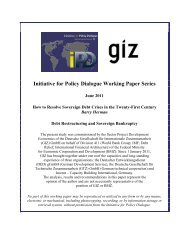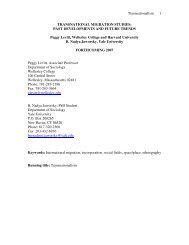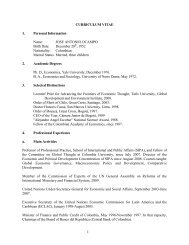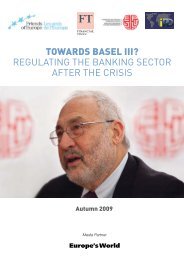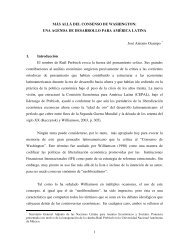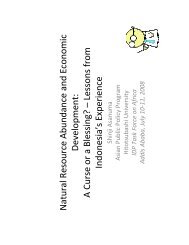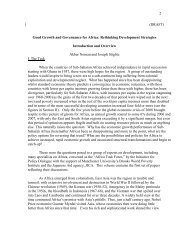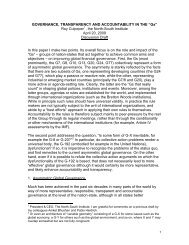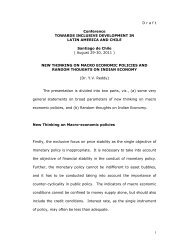Support, financial and political, <strong>for</strong> freedom of in<strong>for</strong>mation legislation should be a priority <strong>for</strong> anyorganization, <strong>for</strong>eign or otherwise, hoping to improve Ghana’s media. It would appear that with therecent election of a new government in Ghana the time is right <strong>for</strong> a renewed push <strong>for</strong> passage ofthe bill, be<strong>for</strong>e the government becomes weighed down by the various interests intent on keepingthe bill’s passage indefinitely postponed.Supplemental funding <strong>for</strong> media coverageMany journalists and non-journalists interviewed suggested that some sort of sponsorship programor journalism fund should be established to improve media coverage in Ghana. As previously noted,journalists’ lack of resources is a major impediment to good media coverage in Ghana. Even editorssuch as The Daily Guide’s Fortune Alimi regretted that his newspaper often does not have the fundsto send his journalists out into the field, especially to places like the mining areas and to whereGhana’s oil has been discovered. According to Alimi, The Daily Guide simply does not have themoney to pay <strong>for</strong> journalists’ travel and expenses, although he wishes he could fund such trips.Most of the recommendations <strong>for</strong> a program to provide funding <strong>for</strong> media coverage fell into threebroad schemes:1. The creation of a fund that journalists could apply to <strong>for</strong> funding <strong>for</strong> a particular businessstory or series of stories;2. The establishment of some sort of sponsorship program which would work with ajournalism-training institution (like the GIJ) or specific media outlets and fund affiliatedjournalists to pursue themes and stories in an area of reporting that is currently lacking suchas the extractive industries;3. The direct financial support and establishment of media outlets along the lines of the NGOfundedPublic Agenda, which could target specific issues like the extractive industries.Optimally, one of these schemes could be developed in tandem with the creation of a business andeconomic journalism training program. Graduates of a new training program in the extractiveindustries, <strong>for</strong> instance, could then apply to a fund dedicated to covering costs <strong>for</strong> stories on miningor the oil industry. Many journalists complained that while they learned a great deal on their trainingprograms, they often couldn’t pursue stories they wanted to after the program ended because theirnews organization simply couldn’t fund such endeavors.Anas Anas, editor with the Crusading Guide, said that while sponsorship programs are useful, theyhave potential downsides as well, particularly if the funding organization has a stake in the issue athand. Anas said that if a story that attacks an oil company is funded, directly or indirectly, by anorganization that advocates <strong>for</strong> environmental issues, it could undermine the story. The oil companymight ‘cry foul,’ and fight back with much greater resources and public relations campaigns,ultimately damaging the report’s credibility. That said, <strong>for</strong> now, the oil and mining companies seemto participate in their own sponsorship in the media as it is. Even if an organization perceived to be"biased" funded advocacy journalism, it would probably only serve to balance out the current stateof affairs, rather than discredit a media that many journalists said was already “bought off.”Finally, there is the model represented by Public Agenda, the hard-hitting public interest newspaperfunded by the Ghanaian-NGO ISODEC. Public Agenda was established precisely as a way to getstories out into the public realm about issues important to Ghanaian civil society that weren’t– 84 –
otherwise being published in the private and state-funded media. While non-profit funding of anewspaper may not be a sustainable enterprise, it does seem to work to some degree.Many interviewees said that Public Agenda was the only publication in Ghana to pursue certainstories, particularly those that might threaten the private sector and there<strong>for</strong>e jeopardize a privatenewspaper’s advertising revenues or directly confront the government over a controversial matter.Precisely because Public Agenda is unique, its influence seems much greater than its circulation(around 10,000/month) might indicate. Moreover, because Public Agenda pursues controversialstories, its reports and articles are regularly re-disseminated, according to several journalists, throughother media, including radio and television. Thus, Public Agenda’s impact is greater than its output.Of course, Public Agenda’s unabashed advocacy journalism meant that some journalists found theirmethods and reporting too provocative.Recommendations <strong>for</strong> UgandaRecommendations <strong>for</strong> Trainings in UgandaLocation, Length and DesignUgandan journalists were fairly evenly split over where to hold the trainings. Some argued that local,inexpensive trainings are the best way to improve the quality of Ugandan journalism because morepeople would be able to attend. Others believed that trainings should take people out of Uganda sothey can focus on the program instead of on daily responsibilities, saying that the exposure this givesjournalists to other environments and developed markets is crucial.The business editors at Uganda’s major daily papers approached the concept of training differentlythan most of those interviewed. One, who said his experience working as a Reuters correspondentwas more useful than any of his trainings, suggested creating an internship program where reportersspend a month with Reuters or with papers in larger media markets, such as South Africa or theUnited States, so they can learn on the job. 226 Another suggested “organizing synergies” withnewsrooms at Reuters, the Financial Times and other major business publications to allow Ugandaneditors to interact with and learn from more experienced colleagues. He also recommended bringingin external facilitators – training editors or consultants – to spend three months at a media companytraining journalists in-house. 227 Both indicated that local media companies need an outsideperspective and that local trainers are less likely to be taken seriously by journalists.Opinions on the optimal program length also differed. Some of those interviewed were in favor oflonger programs – two weeks or more – to give journalists more time to become familiar with newconcepts and skills. Others believed shorter workshops focusing on a single topic would be morebeneficial.Many of those interviewed agreed that more trainers should come from the developing world,mainly Africa and Asia, as they are more likely to be able to relate to journalists in Uganda. Thosewho preferred local trainers emphasized the importance of working with highly experienced226 Ugandan Interviewee #8. 2009. Interview by Rebekah Heacock. Kampala, Uganda, January 8.227 Ugandan Interviewee #10. 2009. Interview by Rebekah Heacock. Kampala, Uganda, January 8.– 85 –
- Page 1 and 2:
THEREWILLBE INKA study of journalis
- Page 3 and 4:
AcknowledgementsThis paper has bene
- Page 7 and 8:
Executive SummaryPurpose of the Rep
- Page 9 and 10:
journalists in these countries that
- Page 11 and 12:
Existing International Training Opp
- Page 13 and 14:
• Consumer Affairs and Informatio
- Page 15 and 16:
Background 3Of the three countries
- Page 17 and 18:
pervasive conflict in the Niger Del
- Page 19 and 20:
3) Crises or disruptions, where som
- Page 21 and 22:
Low pay and low regardOne of the mo
- Page 23 and 24:
Even in cases where working journal
- Page 25 and 26:
But while some reporters think FOIB
- Page 27 and 28:
When asked how much the media could
- Page 29 and 30:
the effects of these challenges for
- Page 31 and 32:
detailed analysis of the opportunit
- Page 33 and 34:
journalist said he has, however,
- Page 35 and 36:
completely make use of some of the
- Page 37 and 38:
money. Their knowledge of what medi
- Page 39 and 40: Notes on conducting research in Nig
- Page 41 and 42: Ghana- 35 -
- Page 43 and 44: evenues each year,” 106 which wou
- Page 45 and 46: entertainment news, scandals, and p
- Page 47 and 48: The rise of business-focused journa
- Page 49 and 50: coverage of the oil industry is als
- Page 51 and 52: needed supplementary income to cash
- Page 53 and 54: as supporting one political party o
- Page 55 and 56: Numerous journalists recounted how
- Page 57 and 58: Training programs available to busi
- Page 59 and 60: Amos Safo, editor-in-chief at the p
- Page 61 and 62: Notes on conducting research in Gha
- Page 63 and 64: Background 136Literacy and Educatio
- Page 65 and 66: “sufficient information” about
- Page 67 and 68: or criminal charges for content the
- Page 69 and 70: have such difficulty obtaining info
- Page 71 and 72: The majority of those interviewed b
- Page 73 and 74: commitment to their profession and
- Page 75 and 76: Notes on Conducting Research in Uga
- Page 77 and 78: Recommendations for Revenue Watch I
- Page 79 and 80: people who have no journalism backg
- Page 81 and 82: analyzes business,” he said, “e
- Page 83 and 84: A journalist with The Punch said,
- Page 85 and 86: The Media Foundation for West Afric
- Page 87 and 88: Length of TrainingRoughly three-qua
- Page 89: industries, for instance, ought to
- Page 93 and 94: Non-Training Recommendations for Ug
- Page 95 and 96: Appendix A: NigeriaPotential Partne
- Page 97 and 98: journalists. Biakolo is very profes
- Page 99 and 100: Television Stations• Nigerian Tel
- Page 101 and 102: have two to four month professional
- Page 103 and 104: City: AccraTelephone: +233 (021) 22
- Page 105 and 106: Fax: +256 414 255 495E-mail: umdf@a
- Page 107 and 108: • What do you think are the most
- Page 109 and 110: Appendix E: Survey Questions1. Name
- Page 111 and 112: 18. How effective were the teaching
- Page 113 and 114: 28. What are the most important cha
- Page 115 and 116: 1. Journalists by Country2. How wou
- Page 117 and 118: 5. How often do you travel out of t
- Page 119 and 120: 9. Which organization(s) sponsored
- Page 121: 12. After completing the training(s



